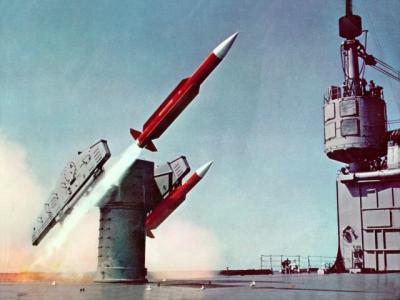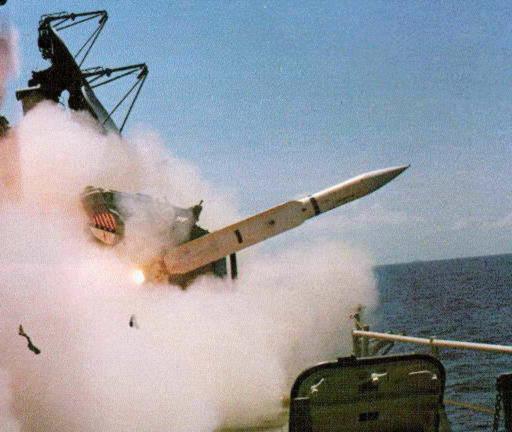General Dynamics (Convair) RIM-24 Tartar
The Tartar was a short/medium-range surface-to-air missile, essentially a SAM-N-7 Terrier HT-3 without the booster stage. Studies to replace Terrier's beam-riding guidance system with a semi-active radar homing system began as early as 1951. SARH guidance would make the missile effective against low-flying targets. Another requirement was to provide a more compact missile system for smaller ships. These goals could be reached by using a tail-controlled Terrier missile with a new radar-honing seeker. The development contract for the Tartar missile was finally awarded in 1955. Interestingly, the Tartar did not receive any SAM-N-n designation, but was known as Missile MK 15 only.
The first full Tartar prototype flew in 1958, and after a lengthy and difficult evaluation period, Tartar was declared operational in 1962. In 1963, the basic Tartar missile was designated as RIM-24A. The RIM-24A had an Aerojet MK 1 end-burning dual-thrust solid-fuel rocket motor. It was effective against targets flying at altitudes between 15 and 15000 m (50 to 50000 ft), at a range between 1.8 and 14 km (2000 yds to 7.5 nm).
 |
| Photo: Hank Morris, USS Norton Sound |
| RIM-24A |
The RIM-24B Improved Tartar had a new seeker, an electronically instead of mechanically scanned radar, and a warhead with better lethality. It also used a new rocket motor, which increased maximum altitude and range to 20000 m (65000 ft) and 30 km (16 nm), respectively. The RIM-24B was produced between 1961 and 1963.
Many missiles were modified under TRIP (Tartar Reliability Improvement Program) program, and were designated as RIM-24C. They had solid-state electronics, improved ECCM, and multiple-target capability. RIM-24C was also known as ITR (Improved Tartar Retrofit). Slight weight reductions increased the maximum range of late-model Tartars to about 32 km (17.5 nm). All Tartar missiles had a viable surface-to-surface capability, with an effective range of about 18 km (20000 yds).
 |
| Photo: U.S. Navy |
| RIM-24B/C (exact model unknown) |
About 2400 RIM-24 missiles of all versions were produced. In U.S. Navy service, the Tartar was replaced by the RIM-66 Standard MR missile.
Specifications
Note: Data given by several sources show slight variations. Figures given below may therefore be inaccurate!
Data for RIM-24B (except where noted):
| Length | 4.72 m (15 ft 6 in); RIM-24A: 4.60 m (15 ft 1 in) |
| Wingspan | 0.61 m (24 in) |
| Finspan | 1.07 m (42.3 in) |
| Diameter | 0.34 m (13.5 in) |
| Weight | 590 kg (1310 lb); RIM-24A: 580 kg (1280 lb) |
| Speed | Mach 1.8 |
| Ceiling | 20000 m (65000 ft); RIM-24A: 15000 m (50000 ft) |
| Range | 30 km (16 nm); RIM-24A: 14 km (7.5 nm) |
| Propulsion | MK 27 solid-fueled dual-thrust (boost/sustain) rocket motor |
| Warhead | 60 kg (130 lb) continuous-rod HE warhead |
Main Sources
[1] Norman Friedman: "US Naval Weapons", Conway Maritime Press, 1983
[2] Bill Gunston: "The Illustrated Encyclopedia of Rockets and Missiles", Salamander Books Ltd, 1979
Back to Current Designations Of U.S. Unmanned Military Aerospace Vehicles
Back to
Directory of U.S. Military Rockets and Missiles
Last Updated: 2 October 2001